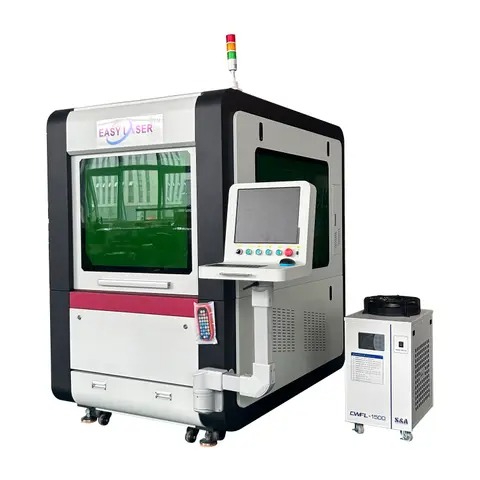Views: 216 Author: Site Editor Publish Time: 2025-07-10 Origin: Site
Proper alignment in a fiber laser cutting machine isn't just a nice-to-have—it's a fundamental requirement for high-precision cuts, optimal performance, and long-term machine health. Misalignment can lead to material wastage, increased maintenance costs, and ultimately a decline in productivity. But how do you ensure your machine remains perfectly aligned throughout its lifecycle? In this article, we'll explore detailed steps, expert tips, and preventative strategies to maintain and verify alignment in fiber laser cutting systems.
Alignment refers to the precise positioning of the laser beam path, optics, worktable, and cutting head in a fiber laser cutting machine. When alignment is off, the beam may not be focused correctly on the material surface, resulting in poor edge quality, inconsistent cuts, and even complete failure to pierce through certain sections.
For industrial applications such as aerospace, automotive, or custom fabrication, micron-level accuracy is often required. Without maintaining proper alignment, even the most advanced machine will deliver suboptimal results. Besides, repeated stress on misaligned components can accelerate wear, shortening the life of lenses, mirrors, and mechanical parts.
Recognizing the early symptoms of misalignment is key to addressing issues before they escalate. Operators should remain vigilant to the following signs:
Inconsistent Cutting Depth – Some areas might be cut deeper than others, indicating an off-focus beam.
Rough or Burned Edges – A misaligned beam can scatter, leading to poor heat distribution.
Increased Burr Formation – More noticeable on thicker metals, burrs suggest uneven beam application.
Lower Cutting Speeds – The system may slow down automatically to compensate for inefficiency.
Frequent Lens or Nozzle Replacements – Misalignment places uneven stress on optical parts.
These indicators serve as your early warning system. Regular observation and maintenance help catch these problems at their inception, before they snowball into production-halting issues.

Alignment in a fiber laser cutting machine involves more than just adjusting screws or recalibrating software. It's a comprehensive process involving both mechanical and optical components. Here's a detailed procedure:
Before performing any alignment procedure, ensure the machine has been powered on and operational for at least 30 minutes. A cold machine may contract slightly and skew alignment readings.
Using a burn paper test or thermal paper at each bend in the laser path (typically inside the beam delivery system), check whether the beam is hitting the center of each optical element. If not, micro-adjustments to the beam bending mirrors are required.
Position a known flat sheet of metal under the laser head and perform a series of test cuts at various focal distances. Determine the sharpest and cleanest cut, and adjust the lens or autofocus parameters accordingly.
Use a concentric circle test or nozzle alignment tool to ensure the nozzle is centered to the beam path. Misaligned nozzles can cause beam refraction, drastically reducing cut quality.
Most modern fiber laser machines offer diagnostic tools that simulate cut paths and compare expected results with real-time feedback. Utilize these tools to refine alignment digitally after manual adjustments.
For precise and safe alignment, specific tools are necessary. The table below summarizes the recommended equipment and their functions:
| Tool Name | Function |
|---|---|
| Thermal Burn Paper | Visualizes laser beam position |
| Micrometer Caliper | Measures cut depth accuracy |
| Laser Power Meter | Assesses output consistency |
| Nozzle Alignment Gauge | Ensures concentricity of beam and nozzle |
| Infrared Safety Goggles | Protects operator from invisible laser exposure |
Using the right tools minimizes human error and reduces the trial-and-error component of alignment work.
Alignment isn't a one-time task—it's part of a broader maintenance routine. The following strategies can help maintain alignment over the long term:
Regular Cleaning: Dust and debris can shift optical elements. Clean lenses, mirrors, and nozzles weekly.
Vibration Monitoring: Excess machine vibration may lead to gradual misalignment. Use vibration dampers or real-time monitors in high-speed environments.
Environmental Control: Fluctuations in temperature and humidity affect metal expansion and contraction. Maintain a stable workshop climate.
Scheduled Calibration: Set up bi-weekly or monthly internal calibration checks depending on workload.
These steps not only preserve alignment but also enhance the longevity of your fiber laser cutting machine.

A1: Ideally, alignment should be checked weekly for high-volume operations or after any mechanical shock, relocation, or major maintenance. Monthly checks may suffice for low-volume or prototyping environments.
A2: Basic alignment tasks, such as checking the nozzle or cleaning lenses, can be handled in-house. However, for beam path calibration or mirror adjustments, a certified technician is recommended due to the high precision and potential risks involved.
A3: Ignoring alignment can result in production losses, frequent part replacements, customer complaints due to quality inconsistency, and even long-term machine damage. It can also lead to safety hazards if beam reflections are uncontrolled.
Let's walk through a real-world scenario. Suppose you've noticed that your machine suddenly starts producing irregular cuts on one edge of a metal sheet. Here's a potential troubleshooting path:
Step 1: Check if the table is level and the sheet is flat.
Step 2: Use burn paper to verify beam path consistency.
Step 3: Inspect the nozzle for any obstructions or warping.
Step 4: Clean the protective lens and check for scratches.
Step 5: Calibrate the focus length using a cut test.
By following this logical progression, most minor misalignments can be quickly diagnosed and resolved without halting operations entirely.
Maintaining proper alignment in a fiber laser cutting machine is as crucial as having a sharp blade in a knife. It impacts everything from cutting quality to machine wear and energy efficiency. While the alignment process can seem daunting, especially to new operators, consistent practice and regular maintenance make it second nature over time.
Investing in the right tools, training your team on alignment protocols, and setting up a preventive maintenance plan can collectively save thousands of dollars in lost productivity and machine repairs. In the world of laser cutting, precision is everything—and alignment is where it all begins.